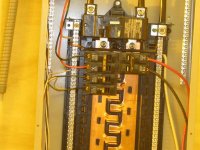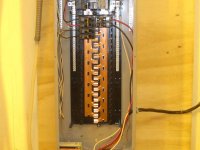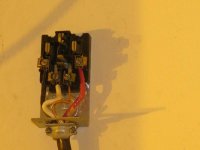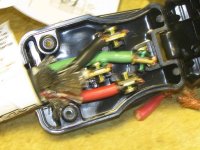You are using an out of date browser. It may not display this or other websites correctly.
You should upgrade or use an alternative browser.
You should upgrade or use an alternative browser.
Growroom Electricity and Wiring
- Thread starter Phillthy
- Start date
I have a question regarding a variac and inline(UFO) fan.
I'm thinking of buying a variac for my PrimaKlima PK100 exhaust fan, to make it run in silence(no buzzing). I'm looking for information regarding which variac is suitable for this fan.
I have a cheap offer on a Metrel HSG 230/3 variac(info on page 3 of this pdf), and am wondering if it is the correct one?
In case anyone has experience with wiring up variacs, I'd also be thankful for some info regarding connecting it with my fan and the 230V current. My fan has 3 wires(one ground), but I think the variac only has connectors for two(no ground). Is this a safety issue? Thank you!
I'm thinking of buying a variac for my PrimaKlima PK100 exhaust fan, to make it run in silence(no buzzing). I'm looking for information regarding which variac is suitable for this fan.
I have a cheap offer on a Metrel HSG 230/3 variac(info on page 3 of this pdf), and am wondering if it is the correct one?
In case anyone has experience with wiring up variacs, I'd also be thankful for some info regarding connecting it with my fan and the 230V current. My fan has 3 wires(one ground), but I think the variac only has connectors for two(no ground). Is this a safety issue? Thank you!
I'm not wild about the idea of using a variac for motors. They work by reducing the voltage, which in turn raises the amperage. An inline fan is a more forgiving application for one than most because the motor is located in the airstream and gets good cooling. That said, they are the recommended speed-control method by some manufacturers - it would be a good idea to check and see if yours is one.
Variacs all work the same way, they are simply variable transformers. You would want sufficient headroom on the specs to provide for the higher current that the motor will pull when slowed down (don't just match the nameplate amperages). The one that you are looking at should be fine, it's rated for a much higher current than the fan.
Grounding is critical, and particularly with a variac. There is a horror story on here somewhere from a fellow who used a cheap Chinese one that the insulation failed on and lit him up. The variac should be mounted in a metal enclosure, and the ground would tie the variac frame and the enclosure together, as well as carrying the ground from the power source through to the fan. The variac enclosure should either be large enough that it isn't going to trap heat and overheat, or be vented. If it is vented, the vents need to be baffled or screened so that you can't accidentally come into contact with energized parts of the variac.
Variacs all work the same way, they are simply variable transformers. You would want sufficient headroom on the specs to provide for the higher current that the motor will pull when slowed down (don't just match the nameplate amperages). The one that you are looking at should be fine, it's rated for a much higher current than the fan.
Grounding is critical, and particularly with a variac. There is a horror story on here somewhere from a fellow who used a cheap Chinese one that the insulation failed on and lit him up. The variac should be mounted in a metal enclosure, and the ground would tie the variac frame and the enclosure together, as well as carrying the ground from the power source through to the fan. The variac enclosure should either be large enough that it isn't going to trap heat and overheat, or be vented. If it is vented, the vents need to be baffled or screened so that you can't accidentally come into contact with energized parts of the variac.
I'm not wild about the idea of using a variac for motors. They work by reducing the voltage, which in turn raises the amperage. An inline fan is a more forgiving application for one than most because the motor is located in the airstream and gets good cooling. That said, they are the recommended speed-control method by some manufacturers - it would be a good idea to check and see if yours is one.
Variacs all work the same way, they are simply variable transformers. You would want sufficient headroom on the specs to provide for the higher current that the motor will pull when slowed down (don't just match the nameplate amperages). The one that you are looking at should be fine, it's rated for a much higher current than the fan.
Grounding is critical, and particularly with a variac. There is a horror story on here somewhere from a fellow who used a cheap Chinese one that the insulation failed on and lit him up. The variac should be mounted in a metal enclosure, and the ground would tie the variac frame and the enclosure together, as well as carrying the ground from the power source through to the fan. The variac enclosure should either be large enough that it isn't going to trap heat and overheat, or be vented. If it is vented, the vents need to be baffled or screened so that you can't accidentally come into contact with energized parts of the variac.
Thanks for the helpful reply!
I'd like to ask how would I go about grounding the variac, when it looks like it only has two outputs and two inputs? Is there another way of doing that with a variac? I have no experience with them and I definitely don't want to end up being lit up by one!
Thanks for the helpful reply!
I'd like to ask how would I go about grounding the variac, when it looks like it only has two outputs and two inputs? Is there another way of doing that with a variac? I have no experience with them and I definitely don't want to end up being lit up by one!
You should be able to ground to any screw/bolt connection on the metal mounting plate or bracket. The ground isn't an internal connection so there may not be a terminal provided, but there is usually a green screw somewhere on the metal portion for grounding. Connecting to the supporting framework will protect it from being energized during a short circuit.
I have a question on the MLC-4x lighting controller I am installing. It comes with universal X plugs that work with both NEMA 6-15 and NEMA 5-15.
My question is can I still use the 5-15 cords from my ballast if I am running this at 220? Is 5-15 supposed to only be used with 110v?
Probably a dumb question, I just want to be as safe as possible, however I already have the 5-15 cords from using the ballast on 110v with no light controller.
My question is can I still use the 5-15 cords from my ballast if I am running this at 220? Is 5-15 supposed to only be used with 110v?
Probably a dumb question, I just want to be as safe as possible, however I already have the 5-15 cords from using the ballast on 110v with no light controller.
I have a question on the MLC-4x lighting controller I am installing. It comes with universal X plugs that work with both NEMA 6-15 and NEMA 5-15.
My question is can I still use the 5-15 cords from my ballast if I am running this at 220? Is 5-15 supposed to only be used with 110v?
Probably a dumb question, I just want to be as safe as possible, however I already have the 5-15 cords from using the ballast on 110v with no light controller.
Those "universal" plugs are junk. They won't meet any code or applicable standard, and are apparently made in a factory that doesn't concern itself with any of those details.
Yes, you can use 5-15 cords on 220v - but again, not legally. The equipment should have 300v insulation, so that isn't an issue, but code compliance and insurance coverage certainly will be. Yes, 5-15 plugs/receptacles are meant for exclusive use on 120v. That shit gives an electrician hives.......
If you are concerned about safety, the MLC-4X should scare the hell out of you. Unless they have changed the design, there is no fusing between the 50 amp feed and the 15 amp receptacles. It, like the receptacles, will not meet code and will very likely void your fire insurance.
Those "universal" plugs are junk. They won't meet any code or applicable standard, and are apparently made in a factory that doesn't concern itself with any of those details.
Yes, you can use 5-15 cords on 220v - but again, not legally. The equipment should have 300v insulation, so that isn't an issue, but code compliance and insurance coverage certainly will be. Yes, 5-15 plugs/receptacles are meant for exclusive use on 120v. That shit gives an electrician hives.......
If you are concerned about safety, the MLC-4X should scare the hell out of you. Unless they have changed the design, there is no fusing between the 50 amp feed and the 15 amp receptacles. It, like the receptacles, will not meet code and will very likely void your fire insurance.
Are any of the commercial brands of these boxes up to code?
edit: seems like the autopilot v2 have some sort of fuse between the feed and receptacles now. However doesnt look like the titan controls or sentinel have this.
Last edited:
Are any of the commercial brands of these boxes up to code?
edit: seems like the autopilot v2 have some sort of fuse between the feed and receptacles now. However doesnt look like the titan controls or sentinel have this.
I am not aware of any commercially available controllers in the US that are code-compliant. I couldn't find any information on the V2, but the other controllers in the Autopilot lineup seem to be of the same ilk as the rest of the competition.
I am not aware of any commercially available controllers in the US that are code-compliant. I couldn't find any information on the V2, but the other controllers in the Autopilot lineup seem to be of the same ilk as the rest of the competition.
here is the newer model, with picture of inside:
https://www.hydrofarm.com/downloads/fc/APCL4DX_APCL8DX_Instructions_V2_2016_4678.pdf
Wish I could find an internal picture of this unit:
https://pan-techcorp.com/-green-house-products/glc-u45
one.sixoneeight
Member
Powerbox units are ETL listed and UL approved
here is the newer model, with picture of inside:
https://www.hydrofarm.com/downloads/fc/APCL4DX_APCL8DX_Instructions_V2_2016_4678.pdf
Wish I could find an internal picture of this unit:
https://pan-techcorp.com/-green-house-products/glc-u45
I see they are too cheap to add a ring or spade terminals to the end of the wires attached to the receptacles, they used the "quickwire" insert.
here is the newer model, with picture of inside:
https://www.hydrofarm.com/downloads/fc/APCL4DX_APCL8DX_Instructions_V2_2016_4678.pdf
Wish I could find an internal picture of this unit:
https://pan-techcorp.com/-green-house-products/glc-u45
There doesn't appear to be any fusing inside, and it is a dead certainty that no device capable of either 120v or 240v operation on the same receptacle will meet code.
Powerbox units are ETL listed and UL approved
As was mentioned on the previous page, they aren't UL approved - they say that they "conform to UL STD 1640", which is limited to[FONT=Arial, Helvetica, sans-serif]: Exhibition halls; Temporary installations in construction sites; Television and movie production studios; Carnivals, fairs and similar locations; Theaters and television studios where audiences are present.
There does not appear to be a UL sticker on them, and as HVAC Guy said, they do not conform to code.
https://standardscatalog.ul.com/standards/en/standard_1640
[/FONT]
I see they are too cheap to add a ring or spade terminals to the end of the wires attached to the receptacles, they used the "quickwire" insert.
They did at least add fuses correct? That's what those big off white colored things on the top half are? Granted they are not replaceable
Its funny I noticed how shitty the quickwire connection on my MLC-4x was. Seems so non ideal for a high amperage connection. Maybe for some speakers or something okay.
I believe the connection for the pan tech is more like a car battery. Its UL 94 V1 certified, seems better (certification anyways) than the powerbox.
I dont have a trustworthy local electrician to deal with. I actually have a patient that is an electrician that I would trust, but he is so busy and I lost his phone number. Waiting for him to call me, but he only picks up like ~6 times a year... He's due though.
edit: Hmm, now I wonder what all the extra stuff that was added to the inside, here is the older version with much less inside:
https://hydrofarm.com/downloads/fc/MLC-4X%20Instructions_5902.pdf
Last edited:
They did at least add fuses correct? That's what those big off white colored things on the top half are? Granted they are not replaceable
Its funny I noticed how shitty the quickwire connection on my MLC-4x was. Seems so non ideal for a high amperage connection. Maybe for some speakers or something okay.
I believe the connection for the pan tech is more like a car battery. Its UL 94 V1 certified, seems better (certification anyways) than the powerbox.
I dont have a trustworthy local electrician to deal with. I actually have a patient that is an electrician that I would trust, but he is so busy and I lost his phone number. Waiting for him to call me, but he only picks up like ~6 times a year... He's due though.
edit: Hmm, now I wonder what all the extra stuff that was added to the inside, here is the older version with much less inside:
https://hydrofarm.com/downloads/fc/MLC-4X Instructions_5902.pdf
Those don't appear to be fuses to me. I would suspect that they are the relays, but there is no way to be sure without a schematic or physically examining one.






